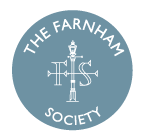On 18 June, our second visit of the season took us to St Albans.
Shortly after the Romans invaded in AD43, they established the city of Verulamium, on the site of an existing Iron Age settlement. In the third century, a Christian convert by the name of Alban was executed on top of a hill just outside the city. He became the first Christian martyr in Britain, and in the eighth century the Saxon king Offa established a Benedictine monastery at the presumed site of his execution.
Our visit ran in reverse chronological order, starting on top of the hill with the Cathedral in the morning and moving down, in the afternoon, to the Roman remains. The cathedral was constructed in the Norman period, and has undergone extensive alteration and renovation since then.
It has the longest nave in Britain, and among the notable features is a Watching Room to monitor pilgrims visiting the shrine of St Alban.
The afternoon took us down to the Roman remains. Much of the Roman city had been demolished in the middle ages, to be recycled as building material especially for the Cathedral. The site was excavated largely by Mortimer Wheeler in the 1930s, with finds on display in a purpose built museum. Some building remains have been left exposed, notably the theatre, which is considered to be the best preserved in Britain.


